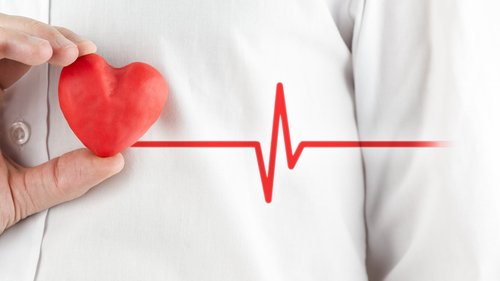How to Tell a Heart Attack from an Anxiety Attack

We can often confuse an anxiety attack with a heart attack, as they have very similar symptoms at first glance.
If you’ve ever been in this situation, or if your nerves have ever played tricks on you, take a look at these differences that will help you distinguish which is which.
Heart attacks: what are they?
A heart attack happens when a blood clot in your coronary artery blocks blood flow and oxygen to your heart.
This causes irregular heart beats, or arrhythmia. In turn, this significantly reduces the ability of your heart to pump blood.
If the obstruction is not treated within a short amount of time, it will cause tissue death in the affected cardiac muscle.
Also read:
Symptoms of a heart attack

- If you’re having a heart attack, you feel an oppressive pain in the center of your chest and possibly in your left arm and back as well.
- Then, the pain may also radiate up your neck, jaw and molars.
- The intensity may vary, but lasts more than five minutes and doesn’t affect your breathing.
- You’ll also feel itching, oftentimes just in your left arm.
- It’s also common to have cold sweats, nausea, and even vomiting.
People having a heart attack don’t have agitated breathing. Therefore, there are very few cases where it triggers an anxiety attack.
If you see that you have some of these symptoms and it’s been more than five minutes, call an ambulance or get to the emergency room immediately.
Anxiety attacks: what are they?

An anxiety attack, also known as a panic attack, consists of a very intense reaction accompanied by a feeling of having no control over your nerves.
Overall, the key lies in figuring out the kind of thoughts that provoked the attack. These tend to be alarmist and trigger a very quick, general physiological activation.
On the physical level, an anxiety happens when the amygdala is overly activated. This part of the brain goes high alert after perceiving a danger.
To try to solve this problem, you’ll have to find out the motives or reasons behind why this alarm went off when there weren’t any dangerous stimuli.
Whatever the case may be, if you have symptoms like this regularly, it’s best to see a doctor to get a proper diagnosis. Psychological treatment will help you discover the true origin of this disorder.
We also recommend:
Symptoms of an anxiety attack

When it comes to anxiety attacks, remember that they can happen in the most ordinary and apparently calm moments of your everyday life.
- In general, the symptoms of an anxiety attack usually last for a maximum of 10 minutes. They consist of intermittent pain in your chest area. It comes and goes.
- In addition, you’ll also notice a numbing sensation and a stabbing feeling. However, it won’t be confined to your left arm. You may also feel it in your right arm, legs, and fingers or toes.
- When someone is having an anxiety attack, they tend to have irrational fears, like going crazy.
However, if you’re not sure if you’re having a heart attack or an anxiety attack, it’s always best to see a doctor immediately. As you can imagine, if you’re having a heart attack and you don’t get to a doctor right away, it could be deadly.
If you have an anxiety attack, seeing a specialist can help you learn to overcome your fears and prevent future attacks.
All cited sources were thoroughly reviewed by our team to ensure their quality, reliability, currency, and validity. The bibliography of this article was considered reliable and of academic or scientific accuracy.
Ornato, J. P., & Hand, M. M. (2001). Warning signs of a heart attack. Circulation. https://doi.org/10.1161/hc2501.093258
Potokar, J. P., & Nutt, D. J. (2000). Chest pain: Panic attack or heart attack? INTERNATIONAL JOURNAL OF CLINICAL PRACTICE.
This text is provided for informational purposes only and does not replace consultation with a professional. If in doubt, consult your specialist.








